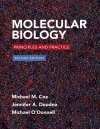About this book
Written and illustrated with unsurpassed clarity, Molecular Biology: Principles and Practice introduces fundamental concepts while exposing students to how science is done. The authors convey the sense of joy and excitement that comes from scientific discovery, highlighting the work of researchers who have shaped and who continue to shape the field today.
This second edition of Molecular Biology: Principles and Practice addresses recent discoveries and advances, corresponding to our ever-changing understanding of molecular biology. In addition to text updates, there are numerous new figures and photos, along with significantly updated figures in every chapter. There are also new end-of-chapter questions for every chapter and many new Unanswered Questions.
- 'Moment of Discovery: each chapter opens with a description of a significant breakthrough in molecular biology relevant to that chapter, as told by the scientist who made the discovery
- Key Conventions: these brief paragraphs clearly lay out for students some fundamental principles often glossed over by instructors and textbooks.
- How We Know: this end-of-chapter section combines fascinating stories of research and researchers with actual experimental data for students to analyze, often drawing on the work of the scientist featured in the chapter’s "Moment of Discovery."Problems (including Data Analysis Problem)
- Problem sets at the end of each chapter give students the opportunity to think about and work with the chapter’s key ideas.
- Each problem set concludes with a Data Analysis Problem, giving students the crucial experience of interpreting real data from actual research (most often the work described in the "How We Know" section).
- Solutions to the problems can be found on the companion Web site.
- Unanswered Questions: a short section at the end of each chapter describes important areas still open to discovery, showing students that even well-covered subjects such as nucleic acid structure and DNA replication are far from fully explored.
The format of Molecular Biology: Principles and Practice is as follows: Molecular Biology: Principles and Practice, Second Edition also has an extensive new media component, such as LaunchPad – a dynamic, fully integrated learning environment that brings together all of our teaching and learning resources in one place. It also contains the fully interactive eBook and other newly updated resources for students and instructors, including:
- Simulations: created using the art from the text, the simulations reinforce understanding of core concepts and techniques by letting students interact with the structures and processes that they have encountered. A game-like format guides students through the simulations, and gradable, multiple-choice questions after each one let instructors assess whether students have thoroughly understood them.
- Nature Articles with Assessment. Specifically selected for both alignment with text coverage and exploration of identified difficult topics, the Nature articles include assessment questions that can be automatically graded. Open-ended questions that are suitable for use in flipped classrooms and active learning discussions either in class or online are also included.
- New Clicker Questions. Instructors can integrate active learning in the classroom and assess students’ understanding of key concepts during lectures.
- Updated Test Bank. The test bank offers at least 40 multiple-choice and short-answer questions for each chapter.
- Key Term Flashcards. Students can review the definitions of all of the glossary terms and quiz themselves.
- Textbook Images and Tables. Available as high-resolution JPEG files, these images have been fully optimized and tested in a large lecture hall to ensure maximum clarity and visibility.
Contents
I. Foundations
1. Evolution, Science, and Molecular Biology
2. DNA: The Repository of Biological Information
3. Chemical Basis of Information Molecules
4. Protein Structure
5. Protein Function
II. Nucleic Acid Structure and Methods
6. DNA and RNA Structure
7. Studying Genes
8. Genomes, Transcriptomes, and Proteomes
9. Topology: Functional Deformations of DNA
10. Nucleosomes, Chromatin, and Chromosome Structure
III. Information Transfer
11. DNA Replication
12. DNA Mutation and Repair
13. Recombinational DNA Repair and Homologous Recombination
14. Site-Specific Recombination and Transposition
15. Transcription: DNA-Dependent Synthesis of RNA
16. RNA Processing
17. The Genetic Code
18. Protein Synthesis
IV. Regulation
19. Regulating the Flow of Information
20. The Regulation of Gene Expression in Bacteria
21. The Transcriptional Regulation of Gene Expression in Eukaryotes
22. The Posttranscriptional Regulation of Gene Expression in Eukaryotes
Appendix: Model Organisms
Glossary
Solutions to Problems
Index
Customer Reviews
Biography
Michael M. Cox is Assistant Chair, Department of Biochemistry at the University of Wisconsin-Madison. He received his B.A. in Biology from the University of Delaware and his Ph.D. in Biochemistry from Brandeis University. Cox's current research activity involves studies of the mechanism of action of proteins involved in genetic recombination. This work is focused on the bacterial RecA protein, the bacterial RecF, RecO, RecR, RecG, RuvA, and RuvB proteins, the yeast Rad 51 protein, and more broadly on the mechanism of the recombinational DNA repair of stalled replication forks.
Jennifer A. Doudna grew up on the Big Island of Hawaii, where she became interested in chemistry and biochemistry during her high school years. She is currently Professor of Molecular and Cell Biology and Professor of Chemistry at the University of California, Berkeley and an Investigator of the Howard Hughes Medical Institute. She received her B.A. in biochemistry from Pomona College and her Ph.D. from Harvard University, working in the laboratory of Jack Szostak, with whom she also did postdoctoral research.
Michael O'Donnell received his Ph.D. at the University of Michigan, where he worked under Charles Williams Jr. on electron transfer in the flavoprotein thioredoxin reductase. He performed postdoctoral work on E. coli replication with Arthur Kornberg and then on herpes simplex virus replication with I. Robert Lehman, both in the biochemistry department at Stanford University. O'Donnell then became a member of the faculty of Weill Cornell Medical College in 1986 and an investigator at the Howard Hughes Medical Institute in 1992 before moving to The Rockefeller University in 1996. O'Donnell is a member of the National Academy of Sciences.
































